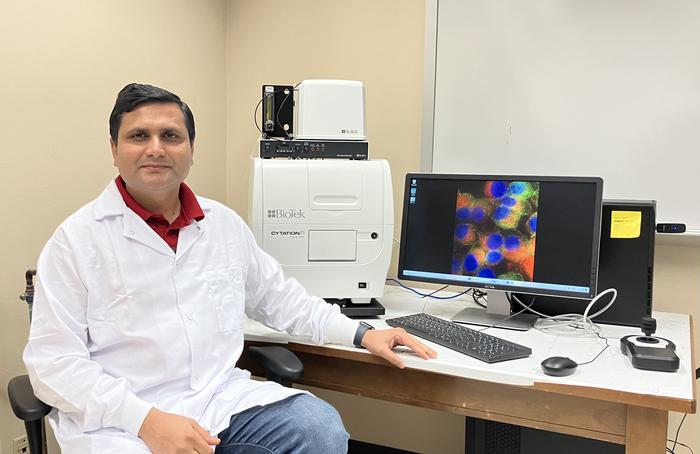The skin, hair and eye color of more than eight billion humans is determined by the light-absorbing pigment known as melanin. An article recently published in the journal Science features research from Vivek Bajpai, Ph.D., lead author and an assistant professor in the School of Sustainable Chemical, Biological and Materials Engineering at the University of Oklahoma, and collaborators from Stanford University. Their research has identified 135 new genes associated with pigmentation.

Credit: Photo provided by the University of Oklahoma
The skin, hair and eye color of more than eight billion humans is determined by the light-absorbing pigment known as melanin. An article recently published in the journal Science features research from Vivek Bajpai, Ph.D., lead author and an assistant professor in the School of Sustainable Chemical, Biological and Materials Engineering at the University of Oklahoma, and collaborators from Stanford University. Their research has identified 135 new genes associated with pigmentation.
Melanin is produced within special structures called melanosomes. Melanosomes are found inside melanin-producing pigment cells called melanocytes. Although all humans have the same number of melanocytes, the amount of melanin they produce differs and gives rise to the variation in human skin color.
“To understand what actually causes different amounts of melanin to be produced, we used a technology called CRISPR-Cas9 to genetically engineer cells,” Bajpai said. “Using CRISPR, we systematically removed more than 20,000 genes from hundreds of millions of melanocytes and observed the impact on melanin production.”
To identify which genes influence melanin production, cells that lost melanin during the gene removal process needed to be separated from millions of other cells that did not. Using in vitro cell cultures, Bajpai developed a novel method to achieve this goal that detects and quantifies the melanin-producing activity of melanocytes. By passing light through the melanocytes, he could record if the light was either absorbed or scattered by the melanin inside.
“If there are a lot of melanin-producing melanosomes, the light will scatter much more than in cells with little melanin,” Bajpai said. “Using a process called side-scatter of flow cytometry, we were able to separate cells with more or less melanin. These separated cells were then analyzed to determine the identity of melanin-modifying genes. We identified both new and previously known genes that play important roles in regulating melanin production in humans.”
The researchers found 169 functionally diverse genes that impacted melanin production. Of those, 135 were not previously associated with pigmentation. They further identified the function of two newly discovered genes: KLF6 and COMMD3. The DNA-binding protein KLF6 led to a loss of melanin production in humans and animals, confirming the role KLF6 plays in melanin production in other species as well. The COMMD3 protein regulated melanin synthesis by controlling the acidity of melanosomes.
Historically, darker pigmentation has been needed to protect against ultraviolet radiation in areas closer to the equator and for people who spend hours in direct sunlight. As humans moved into areas with less direct sunlight or fewer hours of daylight overall, less melanin was needed. Over time, this resulted in melanosomes that produced less melanin, thus absorbing more sunlight.
“By understanding what regulates melanin, we can help protect lighter-skinned people from melanoma, or skin cancer,” Bajpai said. “By targeting these new melanin genes, we could also develop melanin-modifying drugs for vitiligo and other pigmentation diseases.”
The technological processes developed and used by the research team could also be applied to identify genes that regulate melanin production in fungi and bacteria. Melanin production in fungi and bacteria enables them to be more pathogenic to humans or crops. Researchers could develop effective interventions against these microbes and their diseases by discovering and targeting such melanin-producing genes.
Bajpai’s role in the study was completed during his professorship at the University of Oklahoma. However, a portion of this research took place during his postdoctoral research fellowship at Stanford University. A grant from the Oklahoma Center for Adult Stem Cell Research supported the study. Additional funding was provided by the U.S. Department of Defense, CA160997; Howard Hughes Medical Institute; National Institute of General Medical Sciences, NIH R35 GM131757; Stinehart-Reed Award; and the Ludwig Center for Cancer Stem Cell Research and Medicine.
Read more about this research in the article, “A genome-wide genetic screen uncovers determinants of human pigmentation,” in the journal Science. DOI no. 10.1126/science.ade6289
###
About the University of Oklahoma Office of the Vice President for Research and Partnerships
The University of Oklahoma is a leading research university classified by the Carnegie Foundation in the nation’s highest tier of research universities. Faculty, staff and students at OU are tackling global challenges and accelerating the delivery of practical solutions that impact society in direct and tangible ways through research and creative activities. OU researchers expand foundational knowledge while moving beyond traditional academic boundaries, collaborating across disciplines and globally with other research institutions as well as decision makers and practitioners from industry, government and civil society to create and apply solutions for a better world. Find out more at ou.edu/research.
About the University of Oklahoma
Founded in 1890, the University of Oklahoma is a public research university in Norman, Oklahoma. OU serves the state, region and nation’s educational, cultural, economic and healthcare needs. For more information, visit www.ou.edu.
Journal
Science
DOI
10.1126/science.ade6289
Article Title
A genome-wide genetic screen uncovers determinants of human pigmentation
Article Publication Date
11-Aug-2023




